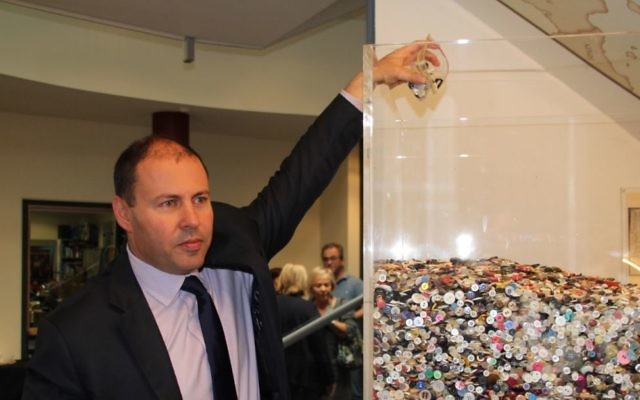Bialik buttons bring tears to the eyes
Josh Frydenberg MP opened Bialik College's Button Project installation last week, featuring 1.5 million collected buttons, each one representing a child killed in the Holocaust.

IT’S been a decade in the making and it has finally come to fruition.
Having collected an incredible 1.5 million buttons over the past 10 years, with each button representing a child killed in the Holocaust, Bialik College officially unveiled its Button Project installation at the school last week.
The exhibition was opened in front of more than 250 guests comprising students, Bialik grandparent Holocaust survivors, Jewish community leaders, and federal and state MPs Josh Frydenberg, John Pesutto, Michael Danby and David Southwick.
Wiping away tears before he addressed the gathering, Frydenberg, a former student at the school, told the guests “as Jews, the Holocaust is integral to our being”.
“What you have done with this Button Project is so important to ensuring the memory of those 1.5 million children – Jews, Gypsies and others – live on,” the Minister for Energy and the Environment added.
Speaking directly to the students in the room about the future of global Jewry, he added, “Children, before their flower was ever allowed to bloom, were lost to this world, to their parents, their grandparents and their future family members.
“The project is not just to commemorate the beautiful memory of 1.5 million children but for you, leaders of our community today and into the future, to say ‘never again’.”
The project was launched in 2007 when a year four Hebrew-English bilingual class decided they wanted a visual commemoration of the children murdered in the Holocaust.
Buttons were chosen because like children, they come in different shapes, sizes and colours. And just as children are at the core of a family, holding it together so too buttons hold things together.
“An outstanding feature of this entire project was the wider communal involvement,” Bialik College principal Jeremy Stowe-Lindner said. “Buttons have been sent to Bialik from all over Australia including from farmers in rural Australia, schools as far north as Alice Springs, Perth, Sydney, Queensland, [as well as] universities and individuals as young as three and older than 93.”
But it wasn’t just Australians who supported the project. “The wider world including America, New Zealand, Israel, Russia and France … many schools of different faiths also held button collection drives and sent us their contributions,” he added.
Also addressing guests was Jewish Holocaust Centre Foundation chair Helen Mahemoff, who reflected on what the project means to the community and the importance of remembrance.
The 1.5 million buttons are divided into a selection of see-through containers representing the different places children were murdered throughout Europe. The most prominent container is the one representing Poland, filled with more than 750,000 buttons and weighing 450 kilograms. Another notable container is the smallest one titled “Unknown”. It represents children murdered in the Shoah who aren’t listed in the records
Last Friday’s event also saw the screening of a trailer of a film currently being produced which tells the story of Bialik’s Button Project.
DANIEL SHANDLER

comments